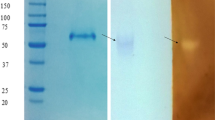Abstract
An anaerobic, sporeforming, galactomannan-degrading bacterium was isolated from methanogenic granular sludge of an UASB reactor used for treatment of wastewater from a sugar refinery. The isolate degraded the polymer rapidly (doubling time was 55 min) and completely in mineral media. The bacterium was classified asClostridium butyricum; the main products were acetate, butyrate, hydrogen, formate, and presumably CO2. The strain produced extracellular endo-mannanase, cell-associated exo-mannanase and intracellular α-galactosidase activity. The mannanases were present when grown on galactomannan, but not after growth on glucose, galactose, or mannose.
Similar content being viewed by others
Abbreviations
- PNPG:
-
p-nitrophenyl-α-D-galactoside
- PNPM:
-
p-nitrophenyl-β-D-mannoside
References
Araki T & Kitamikado M (1988) Exo-1,4-β-mannanase fromAeromonas hydrophila In: Wood WA & Kellogg ST (Eds) Methods in Enzymology, Vol, 160 (pp 583–589). Academic Press, San Diego, New York
Bradford MM (1976) A rapid and sensitive method for the quantification of microgram quantities of protein utilizing the principles of protein dye binding. Anal. Biochem. 72: 248–254
Cato EP, George WL & Finegold SM (1986) GenusClostridium Prazmouski. In: Sneath PHA, Mair NS, Sharpe ME, Holt JG (Eds) Bergeys Manual of Systematic Bacteriology, Vol 2 (pp 1141–1200). Williams and Wilkins, Baltimore
Coen JA & Dehority BA (1970) Degradation and utilization of hemicellulose from intact forages by pure cultures of rumen bacteria. Appl. Microbiol. 20: 362–368
Dehority BA (1965) Degradation and utilization of isolated hemicelluloses by pure cultures of cellulolytic rumen bacteria. J. Bacteriol. 89: 1515–1520
— (1967) Rate of isolated hemicellulose degradation and utilization by pure cultures of rumen bacteria. Appl. Microbiol. 15: 987–993
—, (1968) Mechanism of isolated hemicellulose and xylan degradation by cellulolytic rumen bacteria. Appl. Microbiol. 16: 781–786
—, (1973) Hemicellulose degradation by rumen bacteria. Fed. Proc. 32: 1819–1825
—, & Scott HW (1967) Extent of cellulose and hemicellulose digestion in various forages by pure cultures of rumen bacteria. J. Dairy Sci. 50: 1136–114
Gherardini FC & Salyers AA (1987a) Characterization of an outer membrane mannanase fromBacteroides ovatus. J. Bacteriol. 169 (5): 2031–2037
Gherardini FC & Salyers AA (1987a) Purification and characterization of a cell-associated, soluble mannanase fromBacteroides ovatus. J. Bacteriol. 169 (5): 2038–2043
Hanson RS & Phillips JA (1981) Total carbohydrates by phenol reaction. In: Gerhardt P et al. (Eds) Manual of Methods for General Bacteriology (pp 333–334). American Society for Microbiology, Washington.
Houwen FP, Dijkema C, Schoenmakers CHH, Stams AJM & Zehnder AJB (1987)13C-NMR study of propionate degradation by a methanogenic coculture. FEMS Letters 41: 269–274
DeLey J (1970) Reexamination of the association between melting point, buyaont density and chemical base composition of the deoxyribonucleic acid. J. Bacteriol. 101: 738–754
Lowry OH, Rosebrough NJ, Farr AL & Randau RJ (1951) Protein measurement with the folin phenol reaction. J. Biol. Chem. 193: 265–275
Marmur J (1961) A procedure for the isolation of DNA from microorganisms. J. Mol. Biol. 3: 208–218
Prakash MD (1978) Biochemistry of plant galactomannans. Adv. Carbohydr. Chemistry and Biochem. 35: 341–375
Salyers AA, Vercellotti JR, West SEH & Wilkins TD (1977a) Fermentation of mucin and plant polysaccharides by strains ofBacteroides from the human colon. Appl. Environ. Microbiol. 33: 319–322
Salyers AA, West SEH, Vercellotti JR & Wilkins TD (1977b) Fermentation of mucins and plant polysaccharides by anaerobic bacteria from the human colon. Appl. Environ. Microbiol. 34: 529–533
Voragen AGJ, Schols HA, Searle-van Leeuwen MF, Beldman G & Rombouts FM (1986) Analysis of oligomeric and monomeric saccharides from enzymatically degraded polysaccharides by high performance liquid chromatography. J. Chromatogr. 370: 113–120
Williams AG & Withers SE (1982) The production of plant cell wall polysaccharide-degrading enzymes by hemicellulolytic rumen bacterial isolates grown on a range of carbohydrate substrates. J. Appl. Bacteriol. 52: 377–387
Author information
Authors and Affiliations
Rights and permissions
About this article
Cite this article
Xiuzhu, D., Schyns, P.J.Y.M.J. & Stams, A.J.M. Degradation of galactomannan by aClostridium butyricum strain. Antonie van Leeuwenhoek 60, 109–114 (1991). https://doi.org/10.1007/BF00572700
Received:
Accepted:
Issue Date:
DOI: https://doi.org/10.1007/BF00572700




